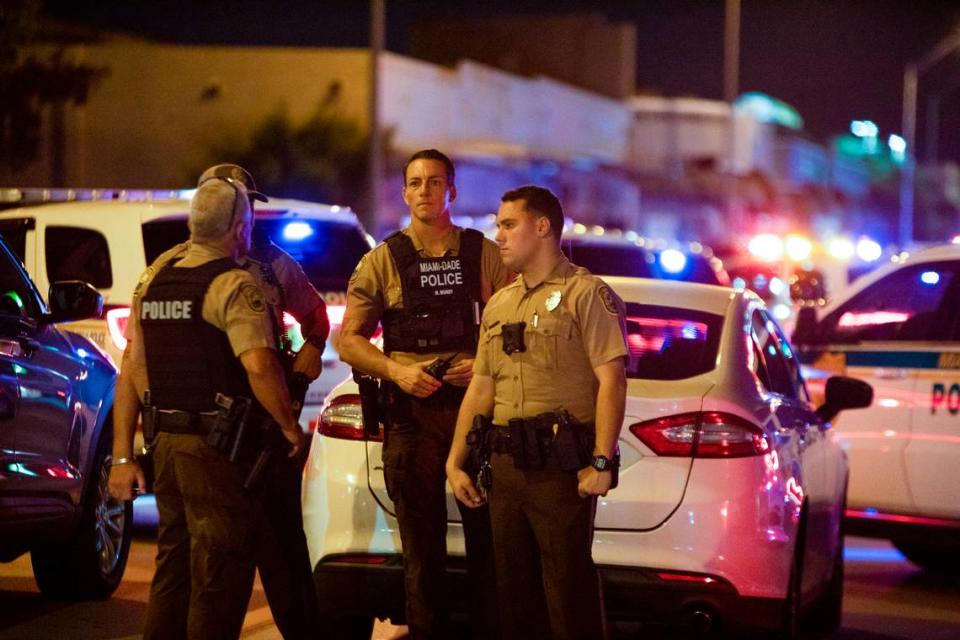The Miami-Dade officer who was shot worked in RID. What is that and what does it do?
Miami-Dade County Police Detective Cesar Echaverry — under watch at a neurological intensive care unit after suffering a gunshot wound to the head Monday night, during a shootout with an armed robbery suspect — works in a unit that specializes in high-risk criminal pursuits
It’s called the Robbery Intervention Detail (RID) section and its detectives operate on the front lines of law enforcement with fewer protections than other tactile units like the SWAT team. Undercover officers in unmarked police cars patrol high-crime neighborhoods in search of known felons and their accomplices. If such fugitives are found, officers make arrests.
“You’re tasked with trying to arrest, infiltrate, dismantle, disrupt criminals,” said Michael Hearns, a retired Coral Gables police officer of 27 years who spent six months on the RID unit. “It is one of the riskier aspects of law enforcement in Miami-Dade County because if there’s a barricaded subject or something, the SWAT team goes in and they are very heavily armed and heavily fortified with protective gear. You’re out there oftentimes just with your ballistic vest.”
Here is some background on a unit whose operations have not been without controversy over the years:
What the Robbery Intervention Detail does
The detectives operate removed from the majority of the police department. They are tuned into a separate radio frequency from the main county or police agency while on duty and attempt to appear unrecognizable as officers.
The undercover officers in unmarked police cars patrol high-crime neighborhoods in search of known felons and their accomplices. If such fugitives are found, officers make arrests. Hearns said RID officers not only wear little armor, but rely almost entirely on small teams.
Former Miami-Dade Police Director Juan Perez said RID typically has 35 to 40 members. According to the Miami-Dade County Police Department’s website, the unit currently consists of 35 members: one municipal detective, two lieutenants, six sergeants and 26 detectives. RID cops mostly wear black t-shirts and dark colored clothing beneath their bulletproof vests to add to the element of surprise and “catch people off guard.”
The element of surprise can be effective. The Miami-Dade County Police Department’s annual report in 2020 lauded RID, alongside other “proactive entities” in the department’s robbery bureau, for a 51% decrease in countywide robbery cases that year. But as proven by Monday’s incident, the element of surprise does not come without its hazards.
“The job itself, at its barest form and at its largest form, is fraught with risk,” Hearns said.

When and why was the RID started?
According to Miami Herald archives, the RID was formed in 1991 to combat a series of tourist robberies and murders in the Miami International Airport area.
“When the RID first started, it was titled the Violence Street Crimes Task Force,” Hearns said. “It was an amalgamation of different agencies, mostly the Coral Gables Police Department, the Florida Department of Law Enforcement, a few [state] troopers and a few from the county.”
Hearns, who served as a RID detective in the ‘90s, said the county quickly decided to contain the team as an in-house operation. That decision led to its current status as a detail exclusive to the Miami-Dade County Police Department. RID’s presence in the county escalated dramatically in its first decade and the department called it a success, citing statistics that cut robberies in half between 1996 and 2001.
Former Miami-Dade County police director Perez said that although RID was originally created to track down robbers, it morphed into a search for wanted shooters and gang members.
“The individuals they are looking for are typically the most violent in our community,” Perez said. “They have lost regard for life.”
Controversy over tactics
Perez said members have to go through in-house RID schooling and training from experienced officers at other agencies. The training differs considerably from patrol officer training.
The RID team’s consistent exposure to threats of violence led Hearns to liken its detectives to trauma surgeons.
“They don’t know what’s going to come through the door,” he said. ”It could be anything from a finger to a severed arm. They’re seeing the full gambit of law enforcement. They are also tasked with dealing with what could be and potentially is some of the more dangerous citizens of our community.”
Still, the RID unit has been embroiled in past controversies regarding use of force.
In September 2000, three RID officers were filmed by television news cameras slugging and kicking a 19-year-old car thief suspect who led them on a chase into Broward County.
The incident, delivered blow-by-blow to viewers across the nation, drew immediate comparisons to the 1991 Rodney King beating in Los Angeles.
The suspect, Jerome McClellion, was later sentenced to 30 years in prison. For their part in the beating, the RID detectives were not criminally charged.
Another RID detective shot an unarmed Black man at a Liberty City Martin Luther King Day celebration in January 2003.
Detective James Anthony Johns shot and killed Palm Beach County resident Eddie Lee Macklin from the hood of his car. According to past coverage in the Miami Herald, “Johns and other police say Macklin gunned the engine, aiming the Lincoln at Johns as officers swarmed around it in bumper-to-bumper traffic on Northwest 22nd Avenue in Liberty City to arrest Macklin. Johns, who believes the car struck him, wound up on the hood and shot Macklin through the windshield.”
Witnesses gave contrasting accounts of the altercation. The death prompted community outrage. But ultimately Johns was deemed justified in his use of force and placed back on active duty within the RID unit.
Miami Herald staff writers Charles Rabin and David Ovalle contributed to this story.

